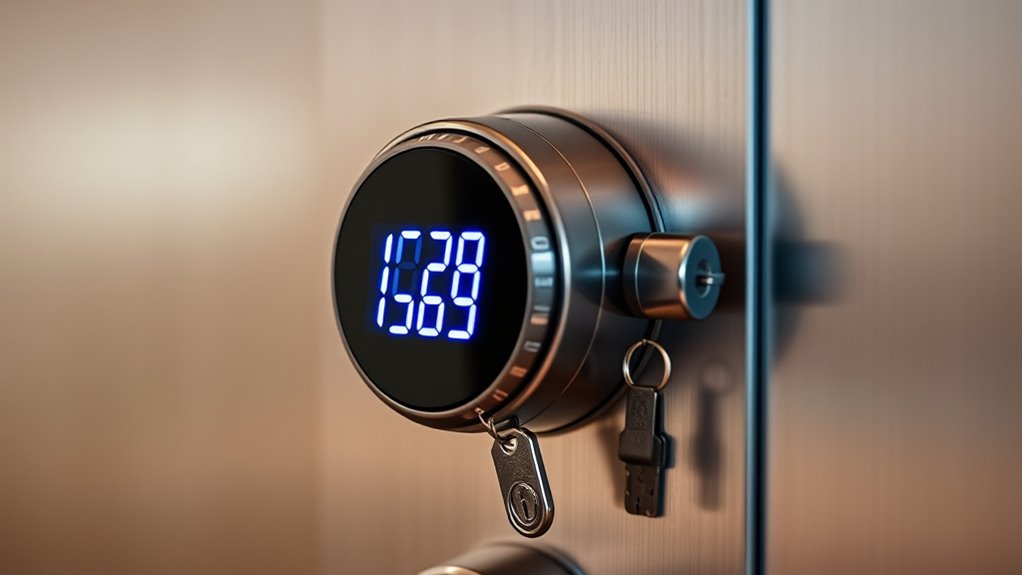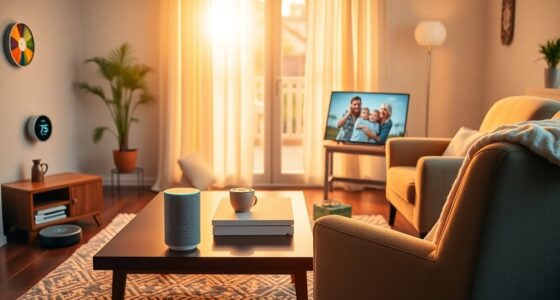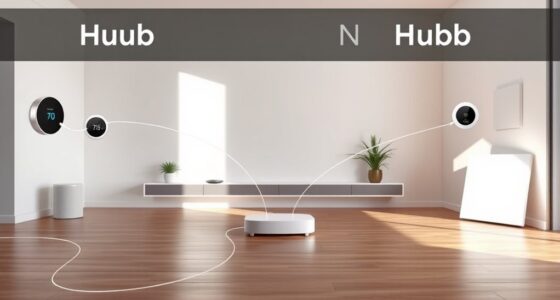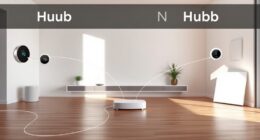To avoid headaches with your smart lock, combine easy-to-manage codes, contactless fobs, and reliable backup methods like hidden keys or mechanical overrides. Set unique codes for family and guests, use fobs for quick, contactless access, and keep a physical key as a backup for emergencies. Regularly update and revoke old access, and follow the manufacturer’s instructions for troubleshooting. Stay prepared: exploring more can help you create a seamless, secure system tailored to your needs.
Key Takeaways
- Use a combination of keypad codes, fobs, and backup keys for flexible, headache-free smart lock access.
- Regularly update firmware and revoke outdated credentials to maintain security.
- Program and manage multiple fobs easily via mobile apps for quick, contactless entry.
- Keep physical backup keys hidden securely to prevent lockouts during electronic failures.
- Follow manufacturer instructions for troubleshooting and support to ensure smooth operation.
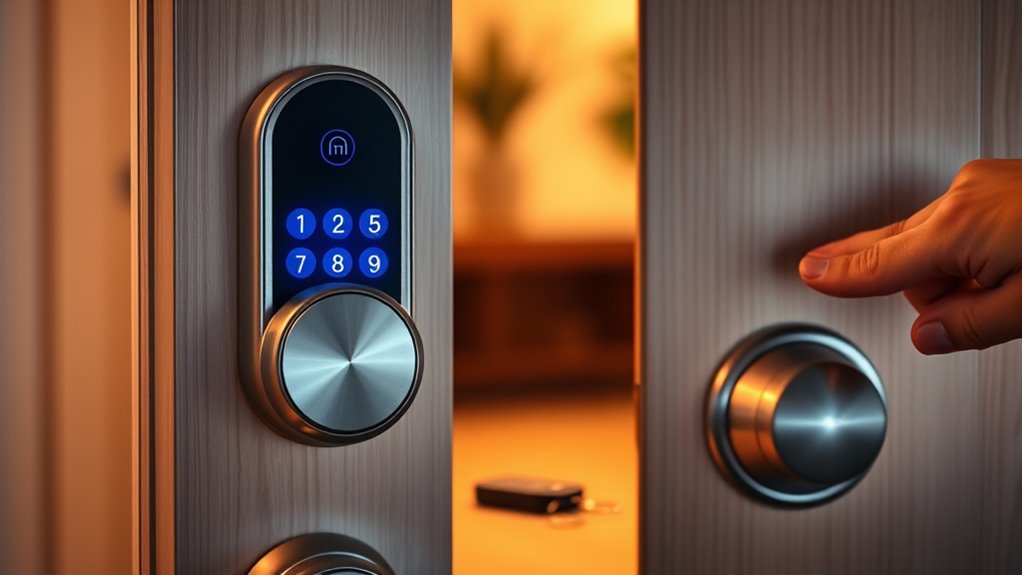
Smart locks can offer convenience and security, but they often come with frustrating technical issues and complicated setups. When you’re trying to get into your home, the last thing you want is to fumble with confusing apps or worry about your lock malfunctioning. Luckily, there are practical ways to avoid these headaches by understanding your options for codes, fobs, and backup systems.
First, using keypad codes is one of the simplest methods. You can set a unique code for yourself and trusted family members, eliminating the need for physical keys. Make sure the lock you choose allows easy code management, so you can change or revoke access as needed. This prevents unauthorized entry if a code gets shared or compromised. The process is straightforward: enter your code on the keypad, and the door opens. It’s reliable, especially if you prefer not to rely solely on Bluetooth or Wi-Fi. Just remember to keep your codes secure and avoid using obvious combinations like “1234” or your birthday.
Fobs are another handy option, offering quick and contactless access. With a compatible fob, you can open your door just by holding it near the lock. These are especially useful for family members, service providers, or guests who visit often. Fobs are simple to program and can be kept on keychains, making them convenient. However, be cautious about losing them—if that happens, you’ll want a quick way to deactivate the lost fob and assign a new one. Many smart lock systems allow you to manage multiple fobs through a mobile app, giving you control without the fuss.
Backup methods are essential because technology isn’t foolproof. Always have a physical key hidden somewhere safe or a mechanical key override. This way, if your lock’s electronic features fail or your app crashes, you can still get inside. Some locks come with keyholes concealed behind a cover, so you don’t have to leave a traditional key in plain sight. Additionally, maintaining a backup plan guarantees you won’t get locked out during power outages or connectivity issues. Choose a lock with multiple options for entry, so you’re never stuck.
Lastly, regular updates and good management are vital. Keep your firmware up-to-date, and regularly review who has access. Removing old codes or deauthorizing lost fobs keeps your system secure. If you encounter issues, read the manufacturer’s instructions carefully or contact support before getting frustrated. By combining codes, fobs, and backup access, you create a flexible system that minimizes headaches and maximizes convenience, so you can enjoy your smart lock without the stress. Additionally, understanding cookie management can help ensure your device and app settings remain secure and private.
Frequently Asked Questions
Can Smart Locks Be Hacked or Compromised?
Yes, smart locks can be hacked or compromised if you’re not careful. Cybercriminals might exploit security vulnerabilities, especially if you use weak passwords or outdated firmware. To protect yourself, always update your lock’s software, choose strong, unique codes, and enable two-factor authentication when available. Regularly monitor your lock’s activity logs and consider additional security measures like encrypted connections to keep your home safe.
What Is the Most Secure Backup Method for Smart Locks?
Think of your smart lock as a castle gate. To keep it secure, your best backup is a physical key stored safely, like a trusty knight’s sword. Use a secure, encrypted cloud backup or a dedicated backup device for digital keys, ensuring only you can access it. This way, even if technology falters, your fortress remains protected, giving you peace of mind and quick access when needed.
Are Smart Locks Compatible With All Home Automation Systems?
Many smart locks are compatible with popular home automation systems like Alexa, Google Assistant, or Apple HomeKit, but compatibility varies by brand and model. You should check your specific lock’s specifications to guarantee it integrates seamlessly with your existing setup. Sometimes, you might need a hub or bridge for full functionality. Always review manufacturer details to confirm compatibility before making a purchase, so your system works smoothly.
How Long Do Batteries Typically Last in Smart Locks?
Back in the day, batteries wouldn’t last, but now, smart lock batteries typically last between 6 months to a year. You’ll want to check your lock’s battery indicator regularly and keep spare batteries handy—just like you’d keep a good ol’ flashlight. High-quality locks with energy-efficient features can extend this period, so you won’t be left out in the cold when the power runs low.
What Should I Do if My Smart Lock Loses Wi-Fi Connection?
If your smart lock loses Wi-Fi, first check your router and internet connection. Restart your router if needed. Make certain the lock’s Wi-Fi settings are correct, and try reconnecting through the app. If issues persist, move the lock closer to your router or add a Wi-Fi extender. Contact customer support for troubleshooting tips or firmware updates. Staying proactive helps keep your lock connected and secure.
Conclusion
So, forget about fumbling with codes, losing fobs, or scrambling for backups. With the right smart lock, you can finally enjoy the luxury of never worrying about keys again—unless, of course, your Wi-Fi goes down, then you’re locked out of modern life entirely. But hey, who needs peace of mind when you can have the thrill of a digital adventure every time you try to get inside? Welcome to the future, where headaches are optional.
